Australian Student Visa Requirements - A Complete Guide
When it comes to studying abroad, international students have a wide variety of options in Australia because of the globally accredited qualifications and some of the world’s best universities. Australian education has a global reputation among employers, and it is no surprise that many students prefer this destination for its excellent learning environment.
Preparing to study in Australia means preparing for a student visa as well. Australian student visa requirements are very much straightforward for an international student to follow through. Nonetheless, to make the visa application process more accessible, this article will help you as a guideline to navigate the tricky turns as well.
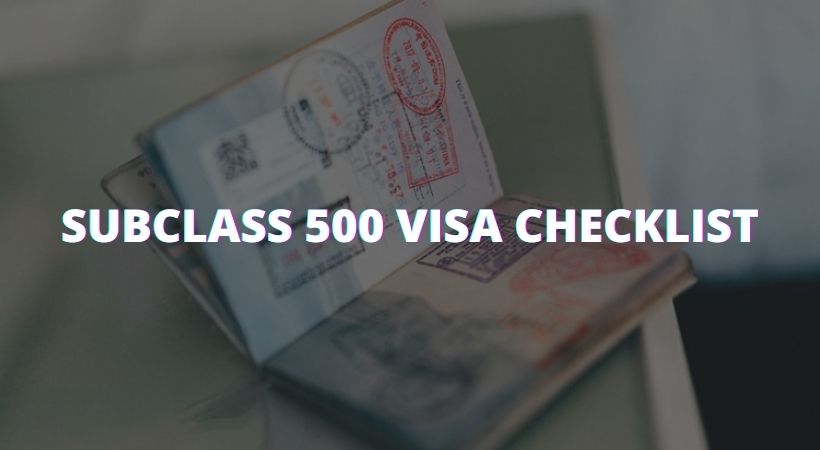
What are the conditions and benefits of Australian Student Visa?
Before applying for an Australian Student visa, you must know the conditions and benefits of holding a student visa or Subclass 500 visa. Regardless of your study area, you have to apply for a Subclass 500 visa as a prerequisite to enter Australia as an international student.
With a Subclass 500 visa, as an international student, you can -
Enroll in any educational institutions and courses enlisted in CRICOS (Commonwealth Register of Institutions and Courses for Overseas Students)
Bring family members or dependents in Australia under the same subclass 500
Work 20 hours every week once the course has been started
Travel to your home country whenever appropriate
Not work as a freelancer or be self-employed
Work only if you are 18 and above
Stay in Australia till the end of your course and sometimes even more.
What are the documents required to apply for Australian Student Visa (Subclass 500)?
It is necessary to prepare all the necessary documents before proceeding with the visa application. One of the critical parts of Australian student visa requirements is arranging and collecting required documents to maintain authenticity within a recent time frame.
All the documents must be scanned in PDF format for online applications, and the maximum file size needs to be 5MB.
In general international students need the following documents to apply for student visa Australia -
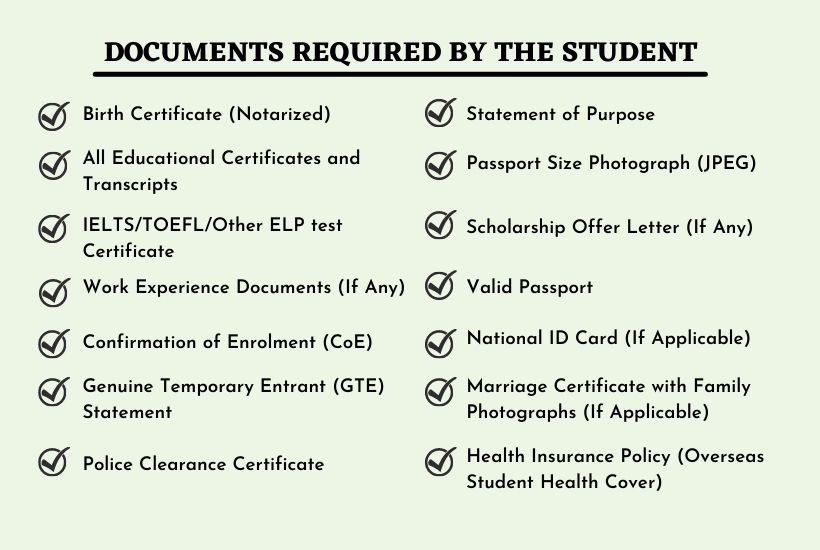
Birth Certificate: The student has to provide their birth certificate either in affidavit or notarization. It is the same if there is any dependent applying with the student as well. You have to keep in mind that the certificate must be translated into English if it is a non-English document.
Educational Certificates and Transcripts: All educational certificates and transcripts until the last education level have to be provided. All the documents have to be arranged chronologically and scanned in a single PDF document. The latest certificate and transcript need to be on top.
IELTS Certificate: Proof of English language proficiency is a must to apply for a student visa Australia. The International English Language Testing System (IELTS) certificate has to be provided with good validity. Please ensure that the certificate has at least six months of validity while applying for a student visa.
Work Experience Document: Proof of employment or work experience certificate must be provided if students have full-time or part-time work experience. Internships are also counted as work experience; therefore, a certificate has to be submitted.
This is particularly important for Masters and Research students. Undergraduate and Foundation level students can avoid this.
Confirmation of Enrollment (CoE): CoE is the proof of your enrolment in the university and is a critical document. You cannot apply for a student visa unless you have CoE in hand. The education provider issues this document as proof that you have enrolled in a specific course within that institution.
You will obtain it electronically once you have accepted the formal offer letter in writing and paid the required tuition fees to the university or education provider.
A sample of CoE is given below -
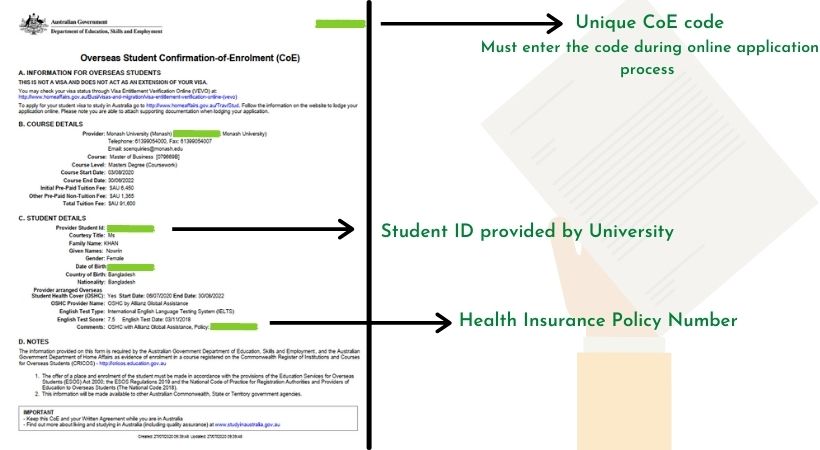
Genuine Temporary Entrant (GTE) Statement: GTE statement is also known as an integrity assessment that all international students should provide while applying for a student visa. This is one of the Australian Student Visa requirements, which will show that you will be going to Australia for a temporary purpose, to study only.
The statement has to be in English and should be supported by evidence. The Australian Government will not weigh generic statements with unsupported evidence.
Statement of Purpose (SOP): SOP is an integral part of the GTE statement for applying for an Australian Student Visa. GTE is a broader version of SOP. However, in SOP, emphasize your education, employment opportunities, and why you chose Australia as your study destination.
This statement has to be in English as well and must be supported by evidence. For example, if you mention any study gap, a document must be submitted to prove your study gap.
Passport Size Photograph: Color photograph has to be provided with size 35mm to 45mm width and 45mm to 5mm length. The photograph has to be recent and no older than six months. For an online application, the photograph has to be in JPEG format.
Scholarship Offer Letter: Any scholarship offer letter, either by the university or any other institution, must be submitted. Proof of any Study Grant has to be provided as well.
Passport: Scanned copy of all the passport pages that you have needs to be submitted. Any previously expired passport has to be submitted as well. If your passport is a non-English document, it has to be translated into English.
National ID Card: Any Identity card issued by the local government can be provided. However, this is not mandatory. But if you own any National ID card, you can submit it to be on the safe side.
Marriage Certificate: Married students have to provide a marriage certificate and some family photographs as proof of marriage.
Police Clearance Certificate: Police clearance is required to validate a student's character and prove no criminal record. The document has to be signed and attested by the regional passport office.
Health Insurance Cover: International students and any dependent student have to obtain Overseas Student Health Cover (OSHC) for the entire duration of the study. The insurance covers visits to doctors, some specific hospital treatment, ambulances, and limited pharmaceuticals.
There are multiple insurance providers in Australia. You can choose based on your convenience. To know more about health insurance and insurance providers, you visit the official website.
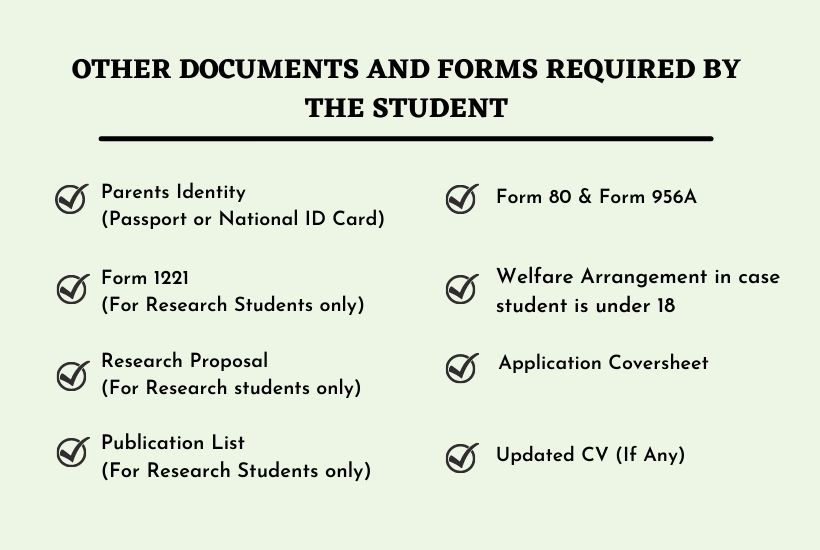
Parent’s Identity: Proof of parents Identity has to be provided. It can be a Passport or a National ID card. In the case of the deceased, a death certificate can also be submitted.
There are certain supplementary forms that you need to fill to submit in the online portal. These forms are not mandatory in many cases, but it is essential to keep them ready if the Australian Home Affairs office asks.
Welfare Arrangement: Welfare arrangement is required if the student is below 18 years of age. This means arranging a legal guardian who is 21 and above and must hold a valid Australian visa to stay till the student is 18. A student can nominate any relative as well who is already staying in Australia.
However, you have to approve your arrangement with the education provider and the Department of Home Affairs.
Form 80: This form is called Personal Particular for Assessment, including Character Assessment. You have to include your details and travel history for the last 10 years in this form.
Form 1221: This form is mainly a requirement for the research students and is almost similar to Form 80. This form is called Additional Personal Particulars information.
Form 956A: You need to submit this form in case you are applying for your visa with a third-party agent or legal practitioner. This form is used for the appointment or withdrawal of authorized recipients.
Application Cover Sheet: A visa application cover sheet is a requirement that will vary from country to country and is usually provided by the Australian High Commission of that region. For example, in the case of Bangladesh, a cover sheet is mandatory.
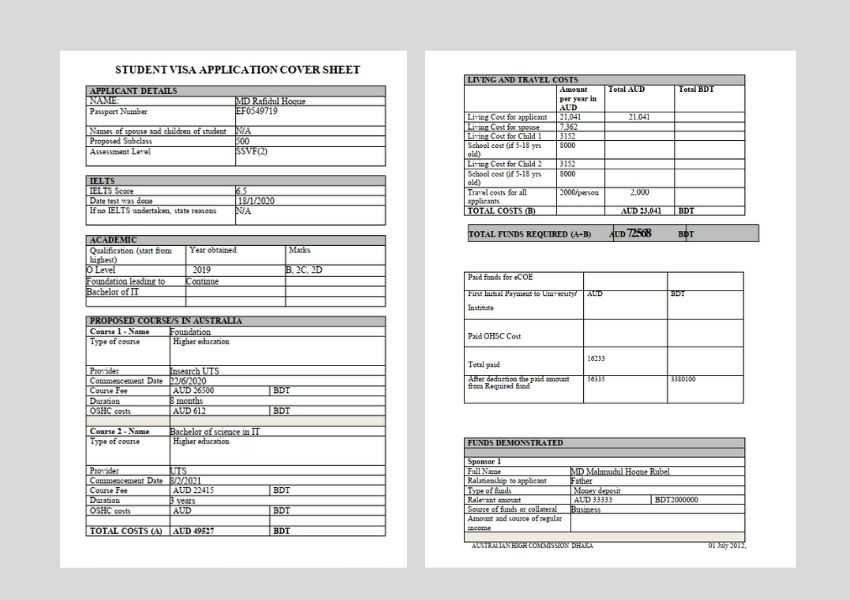
After arranging all these documents, you have to arrange documents of your financial proofs with the help of your sponsor. Funding is crucial for a successful visa application, and it is ideal for showing as much transparency as possible while arranging these papers.

It is advised to check your document requirements with the official Document Checklist tool provided by the Australian Government - Department of Home Affairs. This checklist is updated twice a year. So make sure you update your documents accordingly.
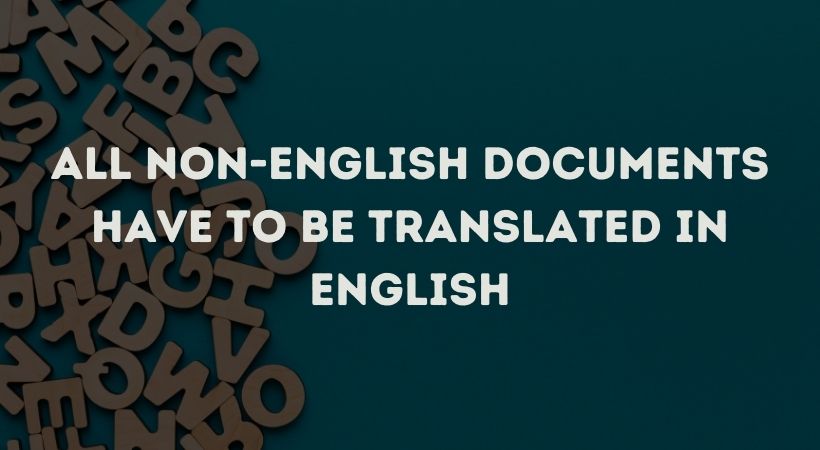
How to Apply Australian Student Visa (Subclass 500)?
For all international students, you must apply for this visa online. The process is straightforward once you have all the required documents in your hand. There are three steps here to follow.
Create or log in to ImmiAccount: ImmiAccount is a single entry point into Australian Online visa services. It is a direct gateway to the Australian Immigration Department. Here you fill up an online application form. Anyone can create an ImmiAccount with a valid email id.
Attach all your documents: Scan and attach all the required documents. The online application form has clear instructions on what documents to attach and where to attach them. Photographs of documents can also be attached, but it has to be clear to show all the information.
However, there is a limit to document attachments. You can upload up to 60 documents for each person. If you are applying with a dependent, then you are allowed up to 100 documents.Pay the visa application fees: Visa application fees can be paid through ImmiAccount with Australian Dollars. The payment method may vary depending on your country of citizenship.
After you are done with the above three steps and submit your application successfully, Health Examination and providing a Biometric is the next step to be followed.
Health Examination: All student visa applicants must meet health requirements because Australia maintains one of the best health standards in the world. The health examinations must be done by a panel of physicians or clinics approved by the Department of Home Affairs.
The panelist can be found on the Department of Home Affairs website or can be collected from your nearest Immigration office. After you are done with the health exams, the authority will automatically update your health results on the ImmiAccount.
However, if your results do not meet the health requirements, you will receive a letter with specific reasons. In this case, a student visa will not be granted. Depending on your result, you may have to apply again for the visa.
To know what tests you have to do and when you can check the website.
Providing Biometrics: After submitting the online application, you will automatically receive an email asking for arranging biometric. Every International student has to provide biometrics at an Australian Visa Application Center (AVAC) or Australian Biometric Collection Center (ABCC).
During your Biometric, the authority will collect a photo of your face with a digital camera and fingerprints.
This is the last step of your subclass 500 visa application process. You will receive messages in your ImmiAccount regarding all the updates, including your status of Visa.

How much Australian Student visa cost?
The Australia study visa fees for Subclass 500 is AUD630. For any dependent who is 18 or above, an additional charge of AUD470 has to be paid. For dependents under 18, the additional charge is AUD155.
You can pay through Credit Card, Paypal, BPAY, and UnionPay. To know more about payment options and overview, visit here.
What is the processing time of Australian Student Visa?
The processing time usually varies depending on which sector you are applying for your student visa. For the Higher Education sector, 75% of students receive their visa outcome within three months. It takes a maximum of 5 months to process a visa in this sector.
For the Postgraduate Research sector, it takes from 4-10 months. Vocational Education and Training Sector students receive their visa outcome within 4-6 months.
Can I get Australian Student visa without IELTS?
The answer is YES! You can apply for a student visa without IELTS. However, providing your English language proficiency certificate is a must while applying for a Subclass 500 visa.
Proof of English Language Proficiency is a must, and the immigration officer may ask you anytime during the process length to provide evidence. IELTS is the widely approved test in this case, but you can also apply with TOEFL, Certificate in Advanced English: Cambridge, PTE, or Occupational English Test.
However, you must take the English Language Test of your preference for a maximum of 2 years before applying for a student visa. Also, there is a minimum score requirement for the English Language Tests.
English Language Test | Minimum Score | Minimum score and at least 10 weeks English Language Intensive course for Overseas students (ELICOS) | Minimum score and at least 20 weeks ELICOS |
International English Language Testing system (IELTS) | 5.5 | 5 | 4.5 |
TOEFL - Internet based test | 46 | 35 | 32 |
Cambridge English : Advanced | 162 | 154 | 147 |
Pearson Test of English Academic (PTE Academic) | 42 | 36 | 30 |
Occupational English Test | B for each test component | N/A | N/A |
Source: https://immi.homeaffairs.gov.au/visas/getting-a-visa/visa-listing/student-500#Eligibility
This is the category list of English Language Tests that the Department approves of Home Affairs. It is mandatory to provide evidence of your English Language skill unless you are exempted.
According to the Department of Home Affairs, the exemption categories are -
Citizen and Passport Holder of UK, USA, Canada, NZ, or Republic of Ireland
An applicant is Foreign Affairs or Defence sponsored student or Secondary Exchange, Student
Enrolled in a main course of study, a registered standalone English Language Intensive Course for Overseas Students (ELICOS), or a course registered to be delivered in a language other than English, or a registered postgraduate research course.
The student has completed at least five years of education in English in one or more of the following countries: Australia, NZ, UK, USA, Canada, South Africa, or the Republic of Ireland.
Completed Senior Secondary Certificate of Education in Australia before two years of applying for the student visa.
This is to keep in mind that the chances of a student visa being granted are higher when you apply with an English Language Test certificate. Also, it is advised to attempt an IELTS test because it has proven to be an accurate indicator of a person's ability to communicate in English.
Can I apply Australian Student Visa after refusal?
It is possible to apply for an Australian Student Visa after refusal. However, it is crucial to understand the reasons behind your visa refusal. Though the reasons for visa rejection vary from person to person but most refusals fall into two categories -
Non-character-related refusal: This means you have unknowingly entered false information on your visa application, or you do not meet the visa requirement criteria. This is the most common type of visa refusal and allows you to file for a review. You are eligible to reapply for a student visa unless there is some notable exception. Other reasons can be - insufficient funds, health concerns, failure to meet English requirements, or failure to meet education requirements.
Character-related refusal: This is more serious and implies that you have failed to meet the character test stated in the Migration Act 1958. This usually means you have some criminal record or in some way are involved in a criminal act.
On this ground, the government can even permanently exclude you from entering Australia, and reapplying for a visa might be very difficult.
Depending on the nature of visa refusal, you can choose different options to salvage your Australian student visa. However, given the complex nature of visa refusals, it is highly advised that you talk with an immigration professional to understand all the pros and cons of the options available.
Usually, the visa refusal letter clearly states the reasons for your refusal and if you can do a review. The visa reapply time is generally 21 days after your refusal, and it is advised to act as quickly as possible after the visa is rejected.

Even though you can re-apply for the student visa anytime after your rejection, you have to be very careful with the given information and documents. You should show strong incentive that after your study you will come back to your country. If necessary, provide strong supporting documents to ensure a successful visa grant.
Is Australian Student Visa Fee Refundable?
The visa application fee of AUS630 is not refundable if the visa gets refused or withdrawn. You can only ask for a refund of your tuition fees from your university or education provider if your visa gets rejected.
Australian student Visa Application is a lengthy process, but it becomes easy if you start preparing for at least six months before your course starts. Try to be as organized as possible with your documents and follow the steps given on the Department of Home Affairs website. For a successful visa grant, just simply follow instructions. That’s it!
DOCUMENT CHECKLIST FOR AUSTRALIAN STUDENT VISA (SUBCLASS 500):
Personal Documents
| Document Name |
Specifics |
| Birth Certificate | Notary / Affidavit |
| All Educational Certificates and Transcripts | Scanned in one PDF |
| IELTS / English Language Testing Certificate | |
| Work Experience Documents | If Any |
| Confirmation of Enrollment (CoE) | |
| Genuine Temporary Entrant (GTE) Statement | |
| Statement of Purpose (SOP) | |
| Passport Size Photograpgh | JPEG |
| Scholarship offer letter | If Any |
| Valid Passport | All Pages Scanned |
| National ID | |
| Marriage Certificate with Family Photograph | If Applicable |
| Police Clearance Certificate | Attested |
| Health Insurance Policy (OSHC) | |
| Proof of Parent's Identity | NID or Passport |
| Updated CV | If Applicable |
| Application Coversheet | |
| Research Proposal | For Research students only |
| Publication List | For Research students only |
| Form 80 | |
| Form 956A | |
| Form 1221 | For Research students only |
| Welfare Arrangement | For students under 18 |
Financial Documents
| Document Name | Specifics |
| Guarantor Form with Signature | Attach Photograph |
| Financial Declaration by Sponsor | |
| Recent Bank Account Statements | For the last 1 year |
| All income source related evidence paper | Photocopies |
| Proof of relationship | If sponsors are other than parents |
| Statutory Declarations | If sponsors are from AUS or NZ |
Roadmap of Australian Student Visa Application Process (Subclass 500)
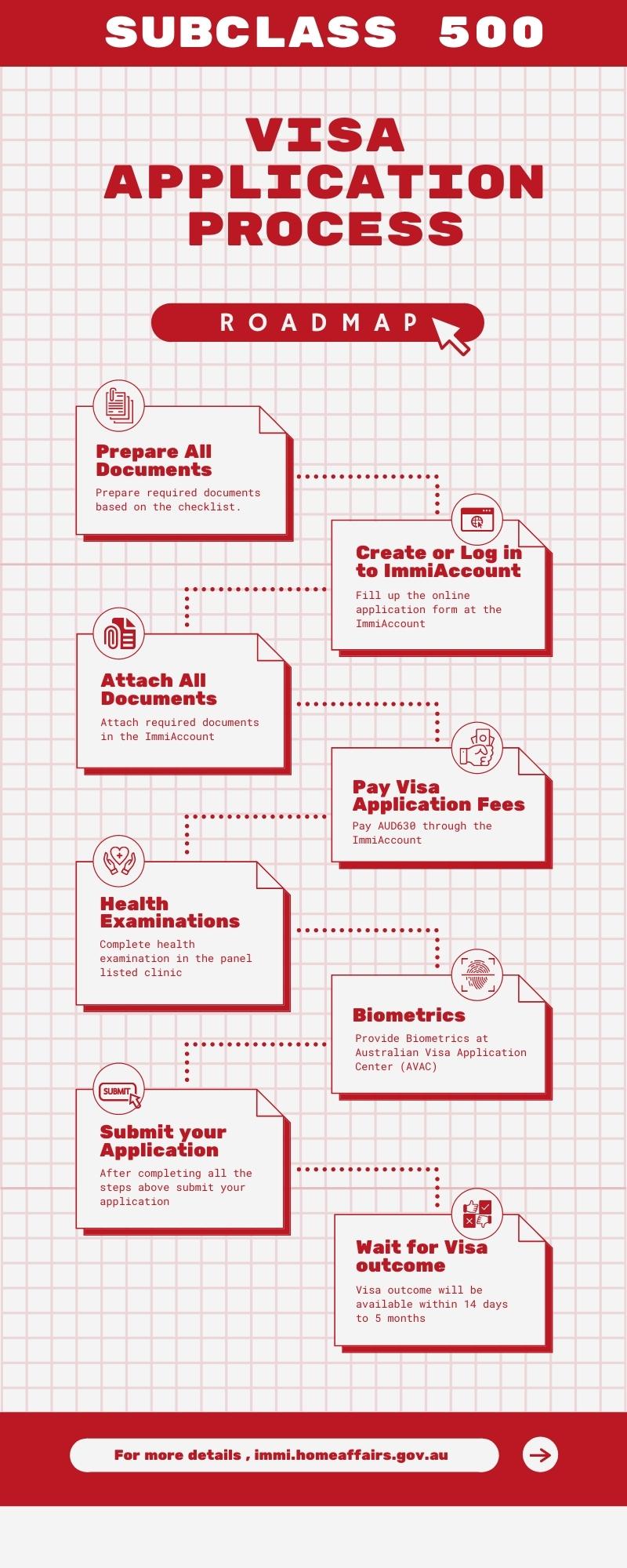

Cover Letter

Forwarding Letter

Student Financial Planning

Explanation Letter of Source of Fund

Explanation on previous Visa Rejection

